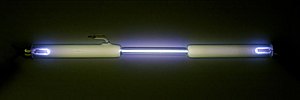 Global Information
Global InformationOxygen information
 Oxygen-filled discharge tube glowing purple. | |||||||||||||||||||||||||||||||
| Oxygen | |||||||||||||||||||||||||||||||
|---|---|---|---|---|---|---|---|---|---|---|---|---|---|---|---|---|---|---|---|---|---|---|---|---|---|---|---|---|---|---|---|
| Allotropes | O2, O3 (ozone) and more (see Allotropes of oxygen) | ||||||||||||||||||||||||||||||
| Appearance | Gas: colorless Liquid and solid: light sky-blue | ||||||||||||||||||||||||||||||
| Standard atomic weight Ar°(O) | |||||||||||||||||||||||||||||||
| |||||||||||||||||||||||||||||||
| Abundance | |||||||||||||||||||||||||||||||
| in the Earth's crust | 461000 ppm | ||||||||||||||||||||||||||||||
| Oxygen in the periodic table | |||||||||||||||||||||||||||||||
| |||||||||||||||||||||||||||||||
| Atomic number (Z) | 8 | ||||||||||||||||||||||||||||||
| Group | group 16 (chalcogens) | ||||||||||||||||||||||||||||||
| Period | period 2 | ||||||||||||||||||||||||||||||
| Block | p-block | ||||||||||||||||||||||||||||||
| Electron configuration | [He] 2s2 2p4 | ||||||||||||||||||||||||||||||
| Electrons per shell | 2, 6 | ||||||||||||||||||||||||||||||
| Physical properties | |||||||||||||||||||||||||||||||
| Phase at STP | gas | ||||||||||||||||||||||||||||||
| Melting point | (O2) 54.36 K (−218.79 °C, −361.82 °F) | ||||||||||||||||||||||||||||||
| Boiling point | (O2) 90.188 K (−182.962 °C, −297.332 °F) | ||||||||||||||||||||||||||||||
| Density (at STP) | 1.429 g/L | ||||||||||||||||||||||||||||||
| when liquid (at b.p.) | 1.141 g/cm3 | ||||||||||||||||||||||||||||||
| Triple point | 54.361 K, 0.1463 kPa | ||||||||||||||||||||||||||||||
| Critical point | 154.581 K, 5.043 MPa | ||||||||||||||||||||||||||||||
| Heat of fusion | (O2) 0.444 kJ/mol | ||||||||||||||||||||||||||||||
| Heat of vaporization | (O2) 6.82 kJ/mol | ||||||||||||||||||||||||||||||
| Molar heat capacity | (O2) 29.378 J/(mol·K) | ||||||||||||||||||||||||||||||
Vapor pressure
| |||||||||||||||||||||||||||||||
| Atomic properties | |||||||||||||||||||||||||||||||
| Oxidation states | −2, −1, 0, +1, +2 | ||||||||||||||||||||||||||||||
| Electronegativity | Pauling scale: 3.44 | ||||||||||||||||||||||||||||||
| Ionization energies |
| ||||||||||||||||||||||||||||||
| Covalent radius | 66±2 pm | ||||||||||||||||||||||||||||||
| Van der Waals radius | 152 pm | ||||||||||||||||||||||||||||||
| Other properties | |||||||||||||||||||||||||||||||
| Natural occurrence | primordial | ||||||||||||||||||||||||||||||
| Crystal structure | cubic | ||||||||||||||||||||||||||||||
| Thermal conductivity | 26.58×10−3 W/(m⋅K) | ||||||||||||||||||||||||||||||
| Magnetic ordering | paramagnetic | ||||||||||||||||||||||||||||||
| Molar magnetic susceptibility | +3449.0×10−6 cm3/mol (293 K)[3] | ||||||||||||||||||||||||||||||
| Speed of sound | 330 m/s (gas, at 27 °C) | ||||||||||||||||||||||||||||||
| CAS Number | 7782-44-7 | ||||||||||||||||||||||||||||||
| History | |||||||||||||||||||||||||||||||
| Discovery | Michael Sendivogius Carl Wilhelm Scheele (1604, 1771) | ||||||||||||||||||||||||||||||
| Named by | Antoine Lavoisier (1777) | ||||||||||||||||||||||||||||||
| Isotopes of oxygen | |||||||||||||||||||||||||||||||
| |||||||||||||||||||||||||||||||
Oxygen is a chemical element; it has symbol O and atomic number 8. It is a member of the chalcogen group in the periodic table, a highly reactive nonmetal, and an oxidizing agent that readily forms oxides with most elements as well as with other compounds. Oxygen is the most abundant element in Earth's crust, and after hydrogen and helium, it is the third-most abundant element in the universe. At standard temperature and pressure, two atoms of the element bind to form dioxygen, a colorless and odorless diatomic gas with the formula O
2. Diatomic oxygen gas currently constitutes 20.95% of the Earth's atmosphere, though this has changed considerably over long periods of time. Oxygen makes up almost half of the Earth's crust in the form of oxides.[4]
All plants, animals, and fungi need oxygen for cellular respiration, which extracts energy by the reaction of oxygen with molecules derived from food and produces carbon dioxide as a waste product. In tetrapods breathing brings oxygen into the lungs where gas exchange takes place, carbon dioxide diffuses out of the blood, and oxygen diffuses into the blood. The body's circulatory system transports the oxygen to the cells, where cellular respiration takes place.[5][6]
Many major classes of organic molecules in living organisms contain oxygen atoms, such as proteins, nucleic acids, carbohydrates, and fats, as do the major constituent inorganic compounds of animal shells, teeth, and bone. Most of the mass of living organisms is oxygen as a component of water, the major constituent of lifeforms. Oxygen is continuously replenished in Earth's atmosphere by photosynthesis, which uses the energy of sunlight to produce oxygen from water and carbon dioxide. Oxygen is too chemically reactive to remain a free element in air without being continuously replenished by the photosynthetic action of living organisms. Another form (allotrope) of oxygen, ozone (O
3), strongly absorbs ultraviolet UVB radiation and the high-altitude ozone layer helps protect the biosphere from ultraviolet radiation. However, ozone present at the surface is a byproduct of smog and thus a pollutant.
Oxygen was isolated by Michael Sendivogius before 1604, but it is commonly believed that the element was discovered independently by Carl Wilhelm Scheele, in Uppsala, in 1773 or earlier, and Joseph Priestley in Wiltshire, in 1774. Priority is often given for Priestley because his work was published first. Priestley, however, called oxygen "dephlogisticated air", and did not recognize it as a chemical element. The name oxygen was coined in 1777 by Antoine Lavoisier, who first recognized oxygen as a chemical element and correctly characterized the role it plays in combustion.
Common uses of oxygen include production of steel, plastics and textiles, brazing, welding and cutting of steels and other metals, rocket propellant, oxygen therapy, and life support systems in aircraft, submarines, spaceflight and diving.
- ^ "Standard Atomic Weights: Oxygen". CIAAW. 2009.
- ^ Prohaska, Thomas; Irrgeher, Johanna; Benefield, Jacqueline; Böhlke, John K.; Chesson, Lesley A.; Coplen, Tyler B.; Ding, Tiping; Dunn, Philip J. H.; Gröning, Manfred; Holden, Norman E.; Meijer, Harro A. J. (May 4, 2022). "Standard atomic weights of the elements 2021 (IUPAC Technical Report)". Pure and Applied Chemistry. doi:10.1515/pac-2019-0603. ISSN 1365-3075.
- ^ Weast, Robert (1984). CRC, Handbook of Chemistry and Physics. Boca Raton, Florida: Chemical Rubber Company Publishing. pp. E110. ISBN 0-8493-0464-4.
- ^ Atkins, P.; Jones, L.; Laverman, L. (2016).Chemical Principles, 7th edition. Freeman. ISBN 978-1-4641-8395-9
- ^ Hall, John (2011). Guyton and Hall textbook of medical physiology (12th ed.). Philadelphia, Pa.: Saunders/Elsevier. p. 5. ISBN 978-1-4160-4574-8.
- ^ Pocock, Gillian; Richards, Christopher D. (2006). Human physiology : the basis of medicine (3rd ed.). Oxford: Oxford University Press. p. 311. ISBN 978-0-19-856878-0.
